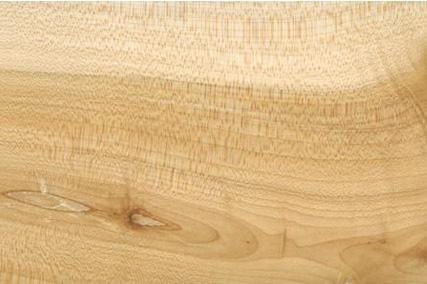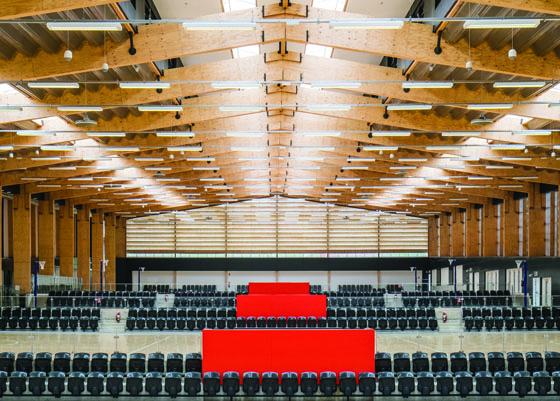The handsome Oregon maple grows on the pacific coast of North America and is prized for furniture and cabinetry veneers.
Maple, Broad-leaved Maple, Big-leaf, British Columbia Maple, Pacific Maple
Acer macrophyllum
The Oregon maple's huge, distinctive leaves are the largest of any maple species. It grows on the pacific coast of North America, from northern British Columbia to California, where it is widely recognised for its superb autumn foliage. It is sometimes used for maple syrup production.
Oregon maple heartwood varies from creamy white to light reddish brown with pinkish hues. The sapwood is reddish-white, sometimes with a greyish cast. Although much of the wood is straight-grained, some highly figured wood, which includes wavy, quilted, fiddle-back or birds-eye grain patterns, is also produced. Growth rings are indistinct and moderately small to medium in size.
Oregon maple is very hardwearing, extremely stable and moderately durable. It can therefore be used for pergolas and structural framing, flooring and interior joinery. Popular for its availability in long lengths, it is only moderately easy to work with. Its high resin content sometimes crystallises on the surface of the timber but can be scraped off when dry. Oregon maple is not good for staining but takes polyurethanes well and oil can add more depth of colour.
Oregon maple is also popular as a veneer for furniture and cabinetry. Its highly figured wood is sought after for musical instruments such as guitar bodies, other stringed instruments and piano frames as well as salad bowls. The Indigenous Lakwungen people of Vancouver Island knew it as the 'Paddle Tree' and created paddles and spindle wheels from its wood.
Shrinkage
| Very Low | Low | Medium | High | Very High | |
|---|---|---|---|---|---|
|
|
|
||||
|
Tangential :
|
4.40% | ||||
|
Radial :
|
2.30% | ||||
|
Unit Movement Tangential:
|
0.25% | ||||
|
Unit Movement Radial:
|
0.13% |
Strength Group
| Very High | High | Reasonably High | Medium High | Medium | Reasonably Low | Low | Very Low | |
|---|---|---|---|---|---|---|---|---|
| Unseasoned: | S1 | S2 | S3 | S4 | S5 | S6 | S7 | S8 |
| Seasoned: | SD1 | SD2 | SD3 | SD4 | SD5 | SD6 | SD7 | SD8 |
Stress Grade
|
Structural No. 1 |
Structural No. 2 |
Structural No. 3 |
Structural No. 4 |
Structural No. 5 |
|
|---|---|---|---|---|---|
| Unseasoned: | |||||
| Seasoned: |
Density per Standard
| Seasoned: | 545kg/m3 |
|---|---|
| Unseasoned: | 440kg/m3 |
Joint Group
| Very High | High | Reasonably High | Medium | Low | Very Low | |
|---|---|---|---|---|---|---|
| Unseasoned: | J1 | J2 | J3 | J4 | J5 | J6 |
| Seasoned: | JD1 | JD2 | JD3 | JD4 | JD5 | JD6 |
Colour
| White, yellow, pale straw to light brown | Pink to pink brown | Light to dark red | Brown, chocolate, mottled or streaky | |
|---|---|---|---|---|
|
|
|
|||
Mechanical Properties
|
Modulus of Rupture - Unseasoned:
|
51 |
|---|---|
|
Modulus of Rupture - Seasoned:
|
74 |
|
Modulus of Elasticity - Unseasoned:
|
8 |
|
Modulus of Elasticity - Seasoned:
|
10 |
|
Maximum Crushing Strength - Unseasoned:
|
22 |
|
Maximum Crushing Strength - Seasoned:
|
41 |
|
Impact - Unseasoned:
|
|
|
Impact - Seasoned:
|
|
|
Toughness - Unseasoned:
|
|
|
Toughness - Seasoned:
|
|
|
Hardness - Unseasoned:
|
2.8 |
|
Hardness - Seasoned:
|
3.8 |
Durability
| Low | Moderate | Reasonably High | High | |
|---|---|---|---|---|
| (0 - 5 yrs) | (5 - 15 yrs) | (15 - 25 yrs) | (more than 25 yrs) | |
|
In-Ground:
|
|
|||
| (0 - 7 yrs) | (7 - 15 yrs) | (15 - 40 yrs) | (More than 40 yrs) | |
|
Above ground:
|
||||
| (0 - 20 yrs, usually < 5) | (21 - 40 yrs) | (41 - 64 yrs) | (More than 60 yrs) | |
|
Marine Borer Resistance:
|
|
Lyctid Borer Susceptibility:
|
|
|---|---|
| Lyctid Borer Susceptibility - Other: | |
|
Termite Resistance:
|
Fire Properties
| 0 | 1 | 2 | 3 | 4 | 5 | 6 | 7 | 8 | 9 | 10 | |
|
EFH Spread-of-Flame Index:
|
|
||||||||||
|
EFH Smoke-Developed Index:
|
|
|
Bushfire Resistance:
|
Not Tested |
|---|
Oregon maple heartwood varies from creamy white to light reddish brown with pinkish hues. The sapwood is reddish-white, sometimes with a greyish cast. Although much of the wood is straight-grained, some highly figured wood, which includes wavy, quilted, fiddle-back or birds-eye grain patterns, is also produced. Growth rings are indistinct and moderately small to medium in size.
Oregon maple is popular in veneer for furniture and cabinetry. Its highly figured wood is sought after for musical instruments such as guitar bodies, other stringed instruments and piano frames as well as salad bowls. It is strong, hard and moderately durable and can be used for pergolas and structural framing, flooring and interior joinery.




